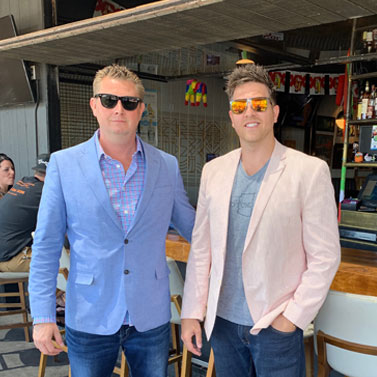A lot of time and toil go into your sipper of tequila or your tumbler of whiskey. We asked the experts to tell us more about the processes that help create some of the world’s favorite drinks.

Dr. Lawrence Weinstein
Chief Medical Officer at American Addiction Centers
Dr. Lawrence Weinstein is an accomplished physician executive with more than 20 years’ experience in managed behavioral healthcare.
The fermentation process is when liquor takes on its signature darker color as well as byproducts called congeners. Congeners are naturally occurring chemicals found primarily in darker liquors such as bourbon, brandy, and whiskey. Wine and tequila are also added to this list. Some studies have suggested that alcohols with higher congener content produce more severe hangover symptoms; in one study, participants drank equal amounts of bourbon and vodka and the next day, 33% of those who drank bourbon reported unfavorable symptoms compared to 3% of those who drank vodka.
The effect that congeners have on the body is completely dependent upon the individual. Acetaldehyde, produced when ethanol is metabolized, is a congener and chemical far more toxic than the alcohol itself. It can severely impact one person and have a minimal effect on another.
Clear alcohol, on the other hand, has a much lower concentration of congeners and produces hangover symptoms less frequently than darker alcohol. Those who suffer from Alcohol Use Disorder tend to consume clear alcohol because hangover symptoms occur less often.
The difference between dark and clear alcohol is the concentration of congeners. The higher the concentration, the more likely that a person will exhibit hangover symptoms to some degree. The more congeners that need to be digested will usually lead to more discomfort.”
Scotch whisky is made from thousands of years of process perfection. Whisky without an “e” is brilliantly made using only pure malted barley and aged a minimum of 3 years in charred oak barrels. The transformation of grain to spirit is brilliantly produced in the mild climate of Scotland. In other words, it’s magic.

John McDonnell and Travis Ranville
John McDonnell is a serial entrepreneur with a brand new whisky venture; Scotchdale. John along with his partner Travis Ranville are the co-founders of Scotchdale Whisky and their mission was to import the very best whisky with the most robust flavor profile to Scottsdale Arizona and go to market with a product that compliments the class of the area they serve.
Luann Lennox
Luann Lennox is the owner and operator of TequilaSnobs. They not only do Tequila tastings, but above all a TequilaSnobs event is a Tequila educational experience. She specializes in only the great agave liquor from Mexico, Tequila! Ms. Lennox has been teaching the marvels of Tequila at in-home parties as well as corporate events for 8 years. Luann began as a non-drinker of any alcohol but was drawn in by the stories, beautiful bottles and great patience she learned it took to create a bottle of Tequila.
Tequila is a very complex spirit. No other liquor can surpass the patience, effort and truly uncontrollable events that go into making Tequila. I do three hour presentations about how Tequila is made, so pressing it into a few paragraphs feels blaspheming. However, without you swirling, sniffing and tasting each sample, I may be able to condense it down.
First comes the plant. With hops and wheat for beer, juniper berries for gin, barley for whiskey and scotch, farmers are able to grow an entire crop in one year. With gmo capabilities sometimes farmers can get 2-3 yields in one growing season! And don’t get me started about the oh so popular Vodka! This stuff can be made from wood pulp, potatoes, molasses, soybeans and even oil byproducts! Tequila is only and always made with the Blue Weber Agave plant. These precious plants must be grown in a certain region of Mexico, the area actually named Tequila or it cannot be called…Tequila!
So back to the GROWING… this huge step is never talked about or even highlighted when there are discussions of liquor making. Above all, with agaves for Tequila the growing “season” is years! Six to ten years! That’s right, no agave may be harvested to make Tequila until it has grown at least six years. Most agave growers and Tequila producers will wait even longer. The older, more mature plants make more sweet sugars – think ripe fruit vs. unripe. Keep in mind [that] during that time, there are uncontrollable laws of nature at work. Wind, rain, sun and temperatures, all mostly uncontrollable, come into play as to when the agaves may be harvested.
Once the field worker, the Jimador (pronounced HE-ma-door) cuts all the arms off the huge agave plant, the center or pina part is baked in a stone oven. There is a heated, in-depth debate about other methods to “cook” the agaves. As with most modernized processes, there are faster, more efficient ways to get the agaves cooked. These acid, hot water, conveyer belt diffusing methods are indeed quick sans even the 2 days it takes to cool the cooked hearts when using original methods. BUT… many purists insist these new “cook quick” processes are a recipe for a disastrous end result Tequila.
Once the center heart of the agave is “cooked” the juices are extracted out of the baked plant. The extraction varies from being smashed by a volcanic stone tahona wheel lead by a donkey to high tech conveyer belt crushers. Yeast is added to the cooked agave juice, and it is left to heat up and ferment. Once the liquid is ready, it is bottled to make a Blanco Tequila (unaged).
Now resting. Master distillers use a multitude of different types of barrels to age their Tequilas. This “resting period” will impart the flavors of the barrel into the welcoming blanco Tequila. New French or American Oak barrels are used to “mellow” the liquid. Whiskey barrels are popular too, but more and more companies are using other resting spots. Used bourbon barrels, rum barrels, cognac, even Bordeaux and Cabernet casts are being used these days.
The aging classification is quite simple. As above, no aging is called blanco. Two months to one year is a Reposado (rested). Aged at least one year to two years becomes an Anejo (aged). There are also Extra Anejos that are rested even longer! So all in all, no other liquor takes the effort and time that a good aged Tequila takes when you consider the growing years and the resting time.
This is a crowdsourced article. Contributors' statements do not necessarily reflect the opinion of this website, other people, businesses, or other contributors
